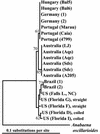Genetic characterization of Cylindrospermopsis raciborskii (cyanobacteria) isolates from diverse geographic origins based on nifH and cpcBA-IGS nucleotide sequence analysis
- PMID: 11976136
- PMCID: PMC127569
- DOI: 10.1128/AEM.68.5.2567-2571.2002
Genetic characterization of Cylindrospermopsis raciborskii (cyanobacteria) isolates from diverse geographic origins based on nifH and cpcBA-IGS nucleotide sequence analysis
Abstract
Isolates of the toxic, N(2)-fixing species Cylindrospermopsis raciborskii from various geographic locations were analyzed with respect to their genetic diversity based on the nifH and cpcBA-IGS genes. Gene sequences clustered according to their geographic origin, with the nifH sequences separating into European, Australian, and American groups and the cpcBA-IGS sequences separating into American and European or Australian groups. PCR primers for both genes were designed to exclusively amplify DNA from Cylindrospermopsis species, and an additional primer set for cpcBA-IGS was designed to specifically amplify the American C. raciborskii strains.
Figures



References
-
- Anderson, R. J., H. A. Luu, D. Z. Chen, C. F. B. Holmes, M. L. Kent, M. LeBlanc, F. J. R. Taylor, and D. E. Williams. 1993. Chemical and biological evidence links microcystins to salmon ‘netpen liver disease.’ Toxicon 31:1315-1323. - PubMed
-
- Atkinson, K. M. 1972. Birds as transporters of algae. Br. Phycol. J. 7:319-321.
-
- Atkinson, K. M. 1980. Experiments in dispersal of phytoplankton by ducks. Br. Phycol. J. 15:49-58.
-
- Baker, P. D., and A. R. Humpage. 1994. Toxicity associated with commonly occurring cyanobacteria in surface waters of the Murray-Darling Basin, Australia. Aust. J. Mar. Freshwater Res. 45:773-786.
Publication types
MeSH terms
Substances
LinkOut - more resources
Full Text Sources

